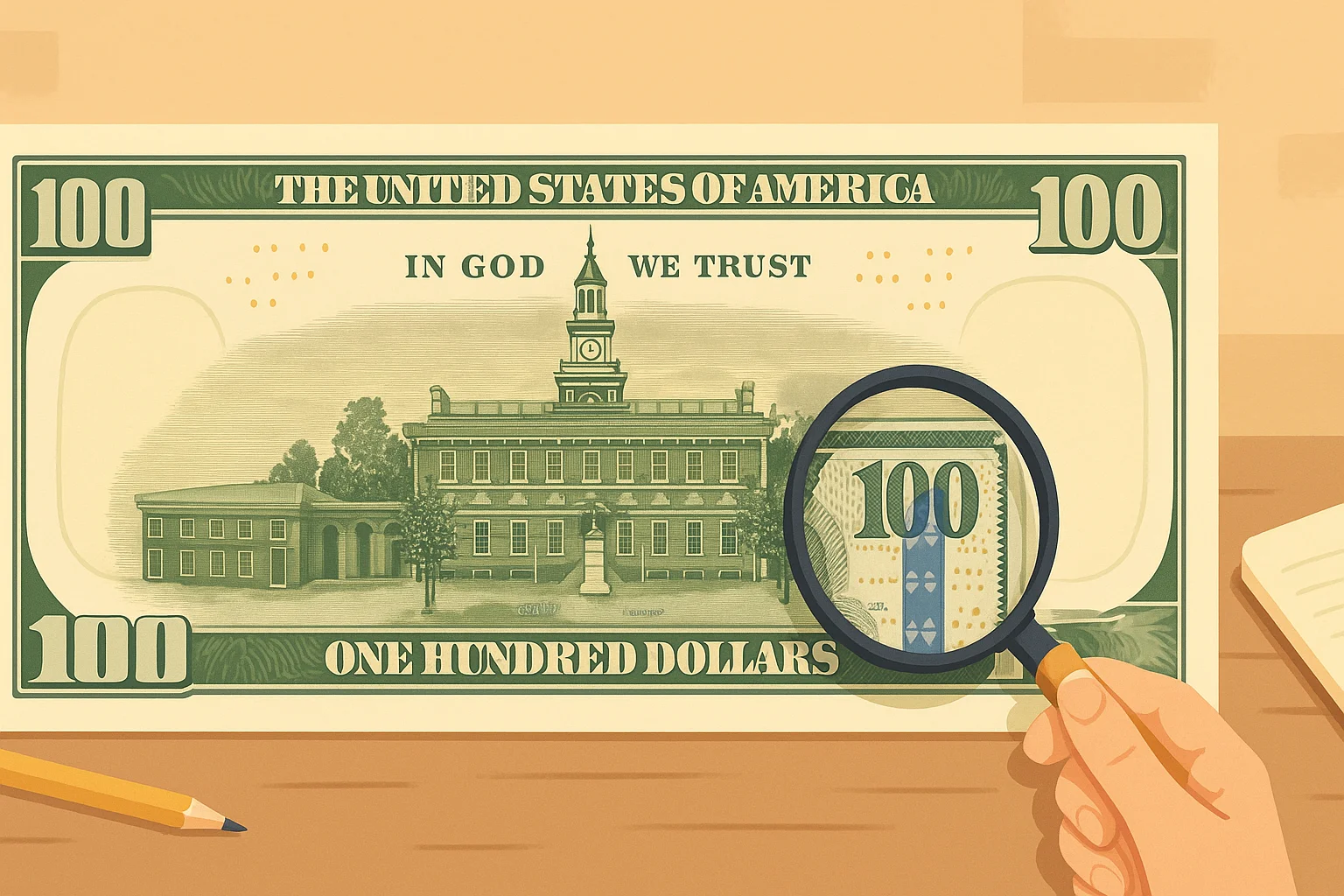The $100 bill is one of the most recognized banknotes in the world, but its look is no accident. Each feature, from Franklin’s portrait to the 3D security ribbon, tells a story about America’s past and its ongoing fight against counterfeiting. Here we trace the design journey of the $100 bill, explaining who is on 100 dollar bill and why the banknote looks the way it does today.

Early Beginnings and Franklin’s Portrait
Before the modern Federal Reserve system, early $100 bills issued in the 1800s looked vastly different. Each bank printed its own notes, often decorated with allegorical figures, ornate patterns, and symbols meant to inspire trust. With the creation of the Federal Reserve in 1913, standardization became essential.
The first Federal Reserve $100 note was released in 1914, and with it came a lasting choice: the portrait of Benjamin Franklin. Unlike other denominations that featured presidents, the $100 bill broke tradition by honoring a Founding Father who was never president. Franklin represented something broader—wisdom, innovation, and statesmanship.
Why Franklin?
Franklin’s image was chosen deliberately. He embodied many of the values the Treasury wanted this bill to convey: intellect, resourcefulness, and stability. From his experiments with electricity to his role in securing independence, Franklin stood as a figure of trust and progress. His portrait set the tone for the $100 bill as the pinnacle of American banknotes.
Standardization in 1928
A major milestone arrived in 1928, when U.S. paper currency was reduced to its current size. The redesign gave the $100 bill the layout we still recognize today. Allegorical designs were replaced with Independence Hall on the reverse, tying the note firmly to American heritage.
This blend of Franklin on the front and Independence Hall on the back created a strong visual narrative: America’s founding ideas of freedom, wisdom, and democracy represented in one piece of currency.
Evolution Driven by Anti-Counterfeiting Needs
As technology advanced, so did the tools available to counterfeiters. By the late 20th century, photocopiers and printers could mimic older designs with alarming accuracy. The $100 bill had to adapt—not just for aesthetics, but for survival. Each redesign became a chess move in the ongoing battle against forgery.
The 1990 Redesign: Subtle but Important
The 1990 series introduced features that were easy for the public to verify but tough for criminals to replicate. Two of the most notable additions were:
Microprinting: Tiny text hidden around Franklin’s portrait and other areas, visible only under magnification.
Metallic Security Strip: A thin embedded thread that appeared under light, clearly marking the bill’s authenticity.
These updates gave the $100 bill its first major defense against modern copying technology.
The 1996 Overhaul: A New Look for a New Era
By 1996, another leap forward was necessary. This redesign was more dramatic, signaling a shift to higher-tech security embedded directly into the note. Key changes included:
Watermark of Franklin: A faint portrait visible when the bill was held up to the light.
Color-Shifting Ink: The numeral “100” in the lower right corner shifted from green to black depending on the angle.
Sharper Portrait: Franklin’s face was enlarged and refined, making fine details harder to reproduce.
Fine-Line Printing: Complex patterns around Franklin and Independence Hall added depth and made counterfeiting nearly impossible with scanners.
Security Threads Retained: Red and blue fibers plus microprinting stayed as subtle but effective defenses.
This version of the bill marked a turning point. It wasn’t just about keeping counterfeiters out—it was about public trust. People could check for watermarks and color shifts themselves, giving confidence that what they held was genuine.
Security Evolution at a Glance
Series Year | Security Features Added | Impact on Design |
1990 | Microprinting, metallic strip | First step toward modern anti-counterfeiting defenses |
1996 | Watermark, color-shifting ink, fine-line printing, sharper portrait | A visible redesign that empowered users to verify notes easily |

Modern High-Tech Design: The 2013 Series
The most dramatic shift in the $100 bill’s appearance came with the 2013 redesign, a project that blended security with symbolism. It was not just about blocking counterfeiters; it was about giving the note a fresh, recognizable look while reinforcing its cultural importance.
Key features introduced in this series included:
3D Blue Security Ribbon: A woven strip with images of bells and “100s” that appear to move when the bill is tilted. Because it is embedded into the paper, not printed, it is nearly impossible to replicate.
Disappearing Bell in the Inkwell: Tilt the note, and the copper-colored bell changes to green, a quick authenticity check for users.
Historic References: A brown quill and faint text from the Declaration of Independence highlight Franklin’s role in America’s founding.
Design Refresh: Franklin’s portrait lost its formal border for a modern, open look, while teal background tones added vibrancy.
The reverse still carries Independence Hall, tying the note back to its original 1928 symbolism. Together, these updates created a bill that looks striking, feels secure, and tells a story about both America’s history and its technological innovation.
Symbolism and Cultural Significance
Every element on the $100 bill serves more than one purpose. The design is not only practical but symbolic:
Franklin’s Portrait represents wisdom, innovation, and diplomacy.
Independence Hall links the bill to America’s founding values.
The Blue Ribbon and Microprinting reflect modern innovation and the fight for trust in financial systems.
The $100 bill is more than money—it is a cultural marker. It dominates international circulation, often seen as a safe store of value abroad. It also appears in art, film, and music, reinforcing its identity as both a practical tool and an icon of prosperity.
How Technology Helps Numismatists Today
Exploring the history of banknotes often leads collectors to coins, where design changes and minting quirks tell equally rich stories. Keeping track of all those details is much easier with digital tools like the Coin ID Scanner app.
This freemium app, available on both Android and iOS, gives collectors the ability to:
Identify coins by photo — simply snap or upload an image.
Access detailed data — minting years, country, type, edge, composition, diameter, weight, and current market value.
Organize collections digitally — building a personal archive that’s always at hand.
Use smart filters (premium) to refine searches by rarity, metal, or period.
Rely on AI Coin Helper for quick and accurate identifications.
A Bill That Tells a Story
The $100 bill is more than currency—it’s a timeline of American history and innovation. From Franklin’s portrait in 1914 to the high-tech blue ribbon of the 2013 series, each redesign reflects both the challenges and values of its era. The bill’s look is no accident; it is a carefully crafted balance of security, symbolism, and tradition.
With tools like the Coin ID Scanner app, the same curiosity that drives interest in the $100 bill can be applied to coins worldwide, turning a hobby into a lifelong journey of discovery.

